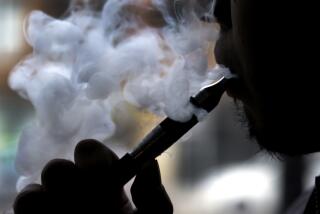Cigarette That Emits Little Smoke Planned
NEW YORK — Bending to America’s anti-smoking tide, the nation’s second-largest cigarette maker said Monday it is developing a more “socially acceptable” cigarette that uses--but doesn’t burn--tobacco.
The radically different cigarette from RJR Nabisco, which won’t be available until at least next year, is designed to produce no ash, no smell and virtually no smoke from the tip after the first few puffs. Smokers would get about 10 puffs of smoke before the cigarette extinguishes itself.
The announcement ignited an outcry from public health officials and anti-smoking campaigners alarmed that such tobacco hybrids may pose new health hazards and renew interest in a habit that adults in growing numbers perceive as unhealthy and unfashionable.
“This development is the most compelling reason yet” for new laws forcing tobacco products to pass the same health and safety tests as other consumer products, said Gregory Connolly of the World Health Organization, a United Nations agency. “It is deplorable that we consumers know more about the black hole of space than about the black hole of Winston-Salem.”
The “black hole” is the critic’s nickname for the plant in Winston-Salem, N. C., where RJR’s tobacco subsidiary, R. J. Reynolds Tobacco Co., has been secretly developing this new cigarette for three years.
For its part, the nation’s second-largest cigarette maker is highlighting the social acceptability of its new cigarette and downplaying the health issues of smoking.
In announcing the concept at a news conference Monday morning, RJR Chairman Edward A. Horrigan Jr. said company officers “are not saying that this is a safe or safer cigarette” because they still “don’t accept the allegations that cigarette smoking is harmful.”
But, because it will “be the world’s cleanest cigarette,” Horrigan said, “we believe it will be well-received by those people who object to tobacco smoke.”
As anti-smoking sentiment has gripped the nation, entrepreneurs have devised products aimed at reducing the risks of cancer and heart disease while still satisfying smokers’ nicotine craving. That explains why consumers can now find nicotine chewing gum, tobacco chewing gum and tobacco toothpaste on store shelves.
But not until now has a cigarette alternative emerged from a cigarette maker.
“This took me totally by surprise,” said Connolly, who is chairman of the World Health Organization’s committee on smokeless tobacco and director of the Massachusetts Department of Health.
“I delivered a paper just last month in which I predicted there would be no move by R. J. Reynolds or any other cigarette company to do any of these alternative products because, if they do, they are admitting in effect that they have a defective product and they’re going to lose their (tobacco) farmers,” he said.
Wall Street was caught off guard, too, even though RJR had been rumored to be exploring new cigarette technologies ever since the company built a heavily guarded research center near its Winston-Salem headquarters about three years ago and refused to discuss it.
“Who would have ever believed it? A cigarette that didn’t burn. This has the nucleus and the foundation to be a very, very significant product,” said Lawrence Adelman, a securities analyst with the investment firm Dean Witter Reynolds.
Investors, who have watched tobacco industry stocks languish for years amid reports linking smoking with lung cancer, weren’t as enthusiastic. RJR’s stock, the third-most active issue on the New York Stock Exchange Monday, fell $1 a share to $66.75, losing some of the $2.875 each of its shares gained on Friday after Cable News Network broadcast reports of a “smokeless cigarette” under development at RJR.
Analysts tied the unenthusiastic reception to the huge cost of developing and marketing such a vastly different product. RJR officers wouldn’t specify either the development cost or the number of employees committed to the project, but analysts estimate that the marketing costs alone would exceed $2 billion and that the company’s profits would be depressed for three to five year as a result.
RJR executives cited news leaks for taking the highly unusual step of announcing a new product well before it is ready for delivery to consumers. Company officers had none of its new cigarettes on display Monday. In fact, Horrigan said that, although he hopes to introduce it in some regions next year, it remains to be seen “whether or when” the cigarette will be introduced.
The apparent haste with which the news conference was arranged led some observers to speculate that this was a bid by RJR to keep its most faithful customers in the wake of a new report on smoking habits. The Centers for Disease Control reported last week that the adult smoking rate has dipped to a new low of 26.5%.
“They’re saying ‘stick with us and we’ll give you something that is safer,’ ” said one public health official.
As for the company’s uncertainty about its new product, company insiders cite discouraging taste-test results.
Horrigan told reporters that RJR has had “very encouraging results” from smoker taste tests. But insiders familiar with the project say smokers have balked at both the taste and the lack of any sensation in the back of their throat--a sensation that many smokers say adds greatly to the pleasure of smoking.
“The sensory qualities of the smoke are a crucial issue for smokers, we have found in our research,” said Jed Rose, chief of the Nicotine Research Center, a joint project of the Veterans Administration Medical Center in Brentwood and the UCLA Neuro-Psychiatric Institute. “If the taste isn’t at least as strong as a real cigarette and it doesn’t feel like a cigarette, I would wonder whether smokers would use it.”
Although Connolly considers the new cigarette the next step in an evolution that started with the filter cigarette in 1954, continued with the low-tar and low-nicotine cigarettes and most recently resulted in cigarettes that are ultra low in tar and nicotine levels, he concedes that the RJR’s new cigarette technology is “ingenious.”
The new cigarette, which Horrigan said hasn’t been named, is packed with about 70% as much tobacco as traditional cigarettes. But the tobacco doesn’t burn when the cigarette is lit. Instead, a “highly refined carbon heat source” in the tip of the cigarette is lit, generating warm air that is drawn through the tobacco, tobacco extracts, flavorings and glycerin to form smoke.
In other words, the smoker is “burning charcoal and getting mostly hot air,” Connolly said.
Because the tobacco doesn’t burn, about 90% of the tar and other tobacco byproducts that have been linked to such diseases as cancer “are eliminated or greatly reduced,” Horrigan asserted. But because the cigarette produces carbon monoxide and nicotine at the same level of a low-tar, low-nicotine Winston light cigarette, it still offers smokers the pleasures of a real cigarette, he said.
Rose, of the Nicotine Research Center, said that, although he is unfamiliar with the mechanics of this product, testing has shown it is possible. “We have found that it is quite possible to come up with a safer cigarette that does preserve the desired sensory effects,” he said.
RJR believes that concerns that smoke inhaled by unsuspecting nonsmokers can cause lung cancer and other serious diseases also will be eased by this new cigarette because it is designed to produce virtually no “side-stream smoke”--that is, smoke that escapes from the tip. Smoke that is inhaled and then exhaled by the smoker is designed to dissipate rapidly.
It is also designed to reduce fire risks. This cigarette is ash-free and isn’t likely to ignite most materials when it is lying flat, the company said.
Nonetheless, many remain skeptical.
“This sounds like a Rube Goldberg device if I ever heard one,” said Mark Pertschuk, executive director of Americans for Nonsmokers’ Rights. “There is a very simple solution to this problem--stop making cigarettes--and it just seems incredibly silly to me that they’re doing this in such a complicated fashion.”
Jan Hitchcock has another concern. “Once again are we going to let them fall through the cracks of regulation with this?” asks the associate director of the Institute for the Study of Smoking Behavior and Policy at Harvard University.
Connolly, who will testify Wednesday before a House subcommittee considering ways to regulate tobacco products, agrees. “It is unfair to the American public that we allow a company to haphazardly design the future.”
More to Read
Sign up for Essential California
The most important California stories and recommendations in your inbox every morning.
You may occasionally receive promotional content from the Los Angeles Times.










